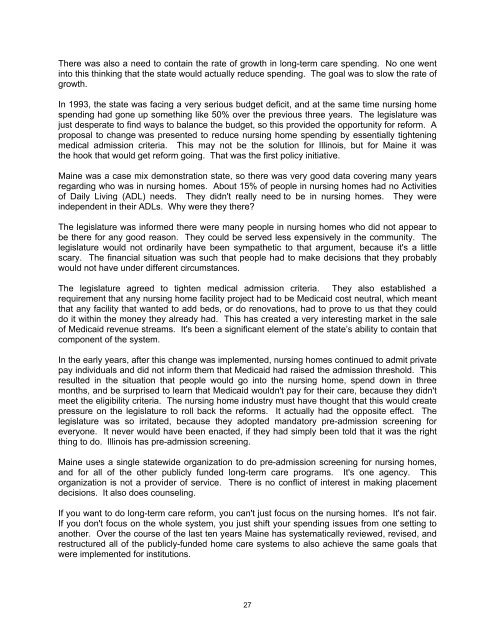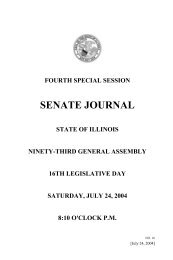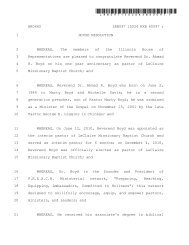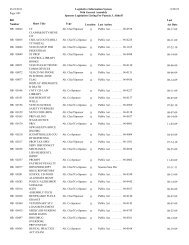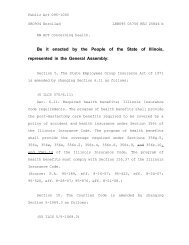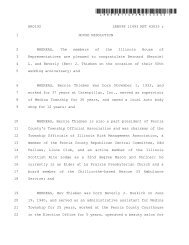Long-Term Care - Illinois General Assembly
Long-Term Care - Illinois General Assembly
Long-Term Care - Illinois General Assembly
You also want an ePaper? Increase the reach of your titles
YUMPU automatically turns print PDFs into web optimized ePapers that Google loves.
There was also a need to contain the rate of growth in long-term care spending. No one went<br />
into this thinking that the state would actually reduce spending. The goal was to slow the rate of<br />
growth.<br />
In 1993, the state was facing a very serious budget deficit, and at the same time nursing home<br />
spending had gone up something like 50% over the previous three years. The legislature was<br />
just desperate to find ways to balance the budget, so this provided the opportunity for reform. A<br />
proposal to change was presented to reduce nursing home spending by essentially tightening<br />
medical admission criteria. This may not be the solution for <strong>Illinois</strong>, but for Maine it was<br />
the hook that would get reform going. That was the first policy initiative.<br />
Maine was a case mix demonstration state, so there was very good data covering many years<br />
regarding who was in nursing homes. About 15% of people in nursing homes had no Activities<br />
of Daily Living (ADL) needs. They didn't really need to be in nursing homes. They were<br />
independent in their ADLs. Why were they there?<br />
The legislature was informed there were many people in nursing homes who did not appear to<br />
be there for any good reason. They could be served less expensively in the community. The<br />
legislature would not ordinarily have been sympathetic to that argument, because it's a little<br />
scary. The financial situation was such that people had to make decisions that they probably<br />
would not have under different circumstances.<br />
The legislature agreed to tighten medical admission criteria. They also established a<br />
requirement that any nursing home facility project had to be Medicaid cost neutral, which meant<br />
that any facility that wanted to add beds, or do renovations, had to prove to us that they could<br />
do it within the money they already had. This has created a very interesting market in the sale<br />
of Medicaid revenue streams. It's been a significant element of the state’s ability to contain that<br />
component of the system.<br />
In the early years, after this change was implemented, nursing homes continued to admit private<br />
pay individuals and did not inform them that Medicaid had raised the admission threshold. This<br />
resulted in the situation that people would go into the nursing home, spend down in three<br />
months, and be surprised to learn that Medicaid wouldn't pay for their care, because they didn't<br />
meet the eligibility criteria. The nursing home industry must have thought that this would create<br />
pressure on the legislature to roll back the reforms. It actually had the opposite effect. The<br />
legislature was so irritated, because they adopted mandatory pre-admission screening for<br />
everyone. It never would have been enacted, if they had simply been told that it was the right<br />
thing to do. <strong>Illinois</strong> has pre-admission screening.<br />
Maine uses a single statewide organization to do pre-admission screening for nursing homes,<br />
and for all of the other publicly funded long-term care programs. It's one agency. This<br />
organization is not a provider of service. There is no conflict of interest in making placement<br />
decisions. It also does counseling.<br />
If you want to do long-term care reform, you can't just focus on the nursing homes. It's not fair.<br />
If you don't focus on the whole system, you just shift your spending issues from one setting to<br />
another. Over the course of the last ten years Maine has systematically reviewed, revised, and<br />
restructured all of the publicly-funded home care systems to also achieve the same goals that<br />
were implemented for institutions.<br />
27


